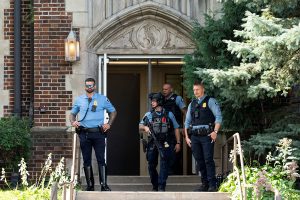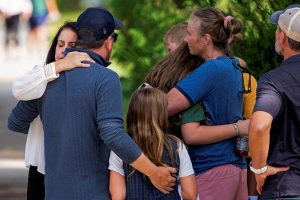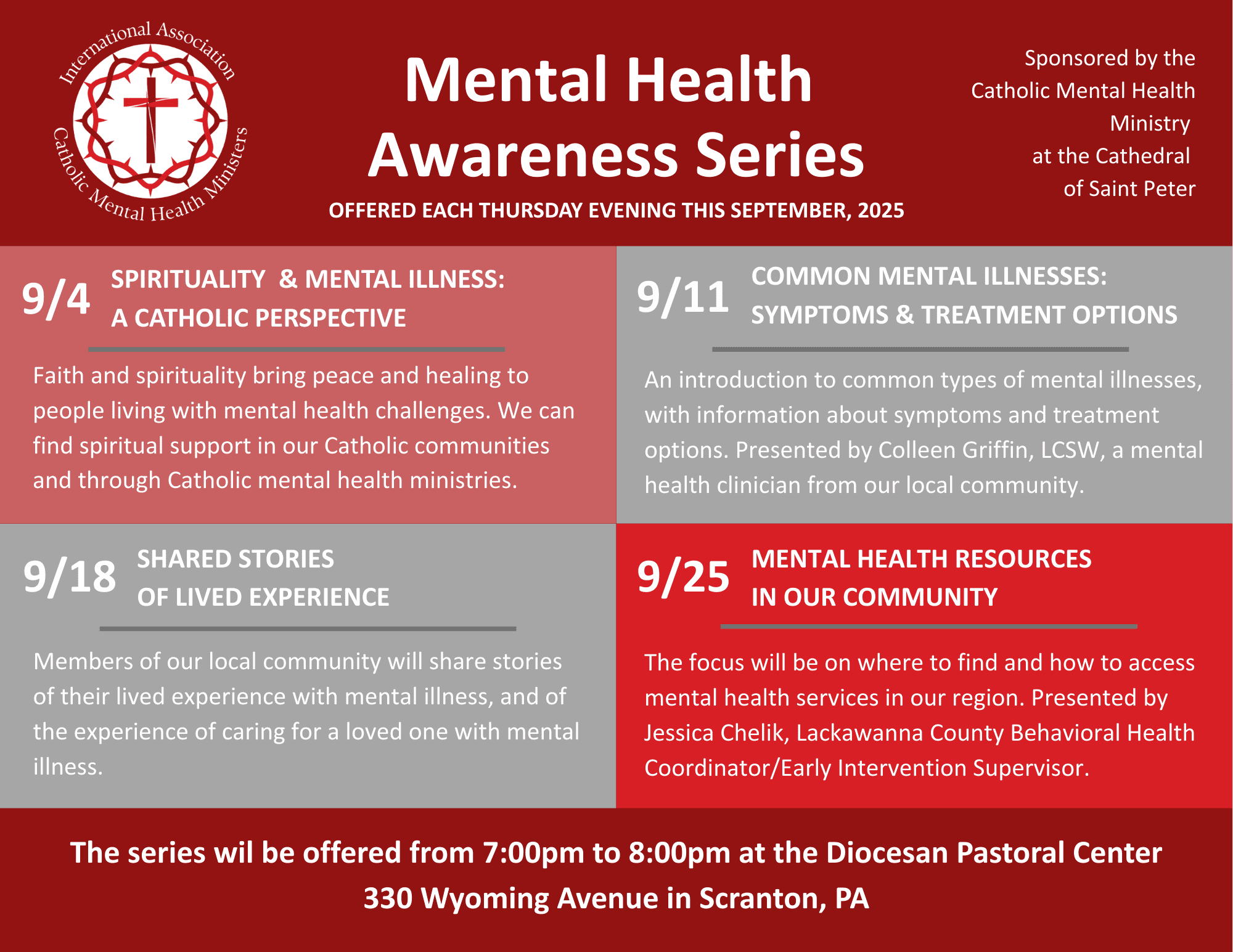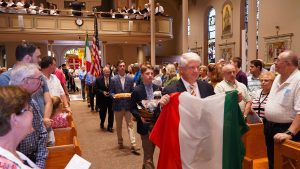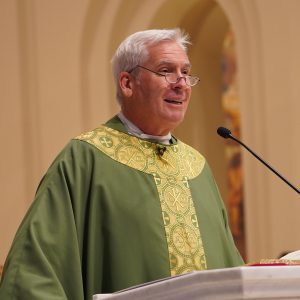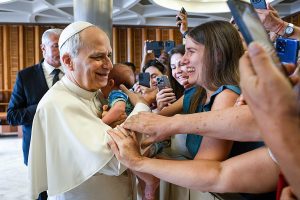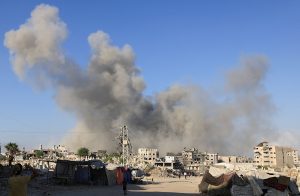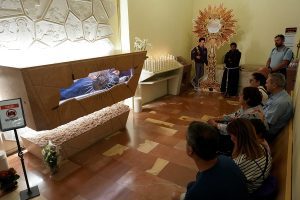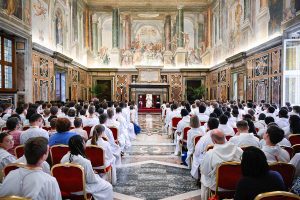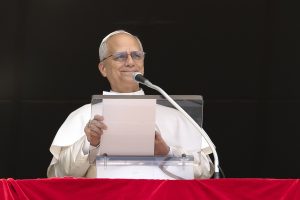ST. PAUL, Minn. (OSV News) – A deadly mass shooting took place the morning of Aug. 27 at Annunciation Catholic School in Minneapolis shortly after the start of the school day during an all-school Mass at the adjacent Annunciation Catholic Church.
The gunman shot from the outside of the church through windows at the Mass attendees with a rifle, shotgun and pistol, killing two children, ages 8 and 10. According to Minneapolis Police Chief Brian O’Hara, 17 others are injured, including 14 children. Three adults who were shot were parishioners in their 80s.
While there were “a range of injuries” among the injured children, they are all expected to survive, O’Hara said during an afternoon press briefing.
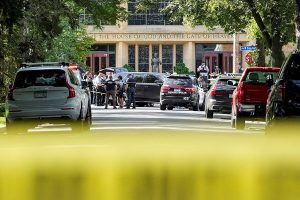
The suspected gunman is also dead and believed to have taken his own life in the parking lot.
Local media is reporting the suspected shooter was 23-year-old Robin Westman, who formerly went by Robert, and that his mother had been an employee of Annunciation.
Court documents filed in Dakota County, accessed by OSV News on Aug. 27, indicate that Westman identified as female and petitioned to formally undergo a name change to reflect that identity. The request was granted on Jan. 15, 2020.
O’Hara confirmed that Westman appeared to have barricaded at least two of the church’s exterior doors with two-by-four wooden boards to trap Mass attendees inside.
Aug. 27 was the third day of the school year for the Catholic elementary school, which serves students in preschool to grade eight. Students were attending an all-school Mass that began at 8:15 a.m. Authorities were alerted at 8:27 a.m.
The mass shooting at Annunciation appears to be the first of its kind involving a Catholic school in the modern era of school shootings that began with the 1999 Columbine High School massacre in Littleton, Colorado.
Minneapolis Mayor Jacob Frey joined O’Hara in speaking to media on the scene during a mid-morning press conference. Dr. Thomas Wyatt, chair of emergency medicine at Hennepin County Medical Center, a Level 1 trauma center in downtown Minneapolis, also provided reporters an update on victims’ status. He said 11 patients were taken to HCMC, among them two adults and nine children ages 6-14.
“Don’t just say this is about thoughts and prayers right now. These kids were literally praying,” Frey said. “They should be able to go to school or church in peace without the fear or risk of violence and their parents should have the same assurance.”
“There are no words that can capture the horror and the evil of this unspeakable act,” he said.
Father Erich Rutten, pastor of nearby St. Thomas the Apostle Parish, arrived on scene this morning to pray with and comfort distraught and grieving parents at the school.
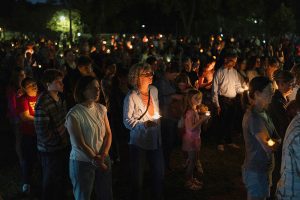
The priest told NBC News that parents were in “great, great anxiety and grief,” with some “wailing and crying, some stooping to the ground.”
He told the news outlet that he hugged those he recognized; several of them joined in as he prayed the rosary.
Bishop Kevin T. Kenney, auxiliary bishop of St. Paul and Minneapolis, who grew up attending Annunciation Parish, rushed from the downtown Minneapolis parish where he serves as pastor to Hennepin County Medical Center to comfort families. He told local ABC affiliate KSTP , “It’s just unbelievable that this could happen, still today.”
It’s “very sad for the community, for the families, and very sad for the families who have lost loved ones,” he said.
“I have talked to a few (families) whose children are in surgery or being cared for,” he added. “Just panicking, of course they’re in shock and worried, asking, ‘Why, why?’ So I’m just here to comfort. They also have a wonderful staff inside as well to comfort the people and to just walk with them in these hours ahead.”
He said, “It’s a horrible, horrific way for all the students to begin the school year. Safety procedures were put in place, people come excited to go back to school, very excited about an academic year, feeling safe in south Minneapolis, and now look what happened.”
Annunciation’s former interim pastor Father Robert Hart, 77, told NBC News that the school shooting was “unbelievable.”
“It’s hard to believe that this could happen at a Catholic Mass,” he said. The priest described Annunciation as a “very close-knit and very supportive” community.
President Donald Trump said on the X social media platform that he has “been fully briefed” on the shooting.
“The FBI quickly responded and they are on the scene,” he said. “The White House will continue to monitor this terrible situation. Please join me in praying for everyone involved!”
Also on X, Minnesota Gov. Tim Walz said that he has been “briefed on a shooting at Annunciation Catholic School and will continue to provide updates as we get more information. The BCA and State Patrol are on scene. I’m praying for our kids and teachers whose first week of school was marred by this horrific act of violence.”
Kristi Noem, secretary of the U.S. Department of Homeland Security, said on X that “DHS is monitoring the horrific shooting at Annunciation Catholic School in Minneapolis. We are in communication with our interagency partners, and will share more information as soon as it becomes available. I am praying for the victims of this heinous attack and their families.”
Bishops and Catholic leaders across the country have issued their condolences and offered prayers in solidarity with the church in Minnesota.
“As a Church, we are following the tragic news from Annunciation School in Minneapolis with heartbreaking sadness,” said Archbishop William E. Lori, vice president of the U.S. Conference of Catholic Bishops, in a statement. “Whenever one part of the Body of Christ is wounded, we feel the pain as if it were our very own children. Let us all beg the Lord for the protection and healing of the entire Annunciation family.”
Pope Leo XIV also offered prayers, according to a message to Archbishop Bernard A. Hebda of St. Paul and Minneapolis from Cardinal Pietro Parolin, the Vatican secretary of state.
“His Holiness Pope Leo XIV was profoundly saddened to learn of the loss of life and injuries following the shooting that took place at Annunciation Church in Minneapolis, and he sends his heartfelt condolences and the assurance of spiritual closeness to all those affected by this terrible tragedy, especially the families now grieving the loss of a child,” he wrote.
“While commending the souls of the deceased children to the love of Almighty God, his Holiness prays for the wounded as well as the first responders, medical personnel and clergy who are caring for them and their loved ones,” Cardinal Parolin continued. “At this extremely difficult time, the Holy Father imparts to the Annunciation Catholic School community, the Archdiocese of Saint Paul and Minneapolis and the people of the greater Twin Cities metropolitan area his apostolic blessing as a pledge of peace, fortitude and consolation in the Lord Jesus.”
In a statement, Archbishop Bernard said he was grateful for prayers and asked that they continue.
“I beg for the continued prayers of all of the priests and faithful of this Archdiocese, as well for the prayers of all men and women of good will, that the healing that only God can bring will be poured out on all those who were present at this morning’s Mass and particularly for the affected families who are only now beginning to comprehend the trauma they sustained,” he said.
“My heart is broken as I think about students, teachers, clergy and parishioners and the horror they witnessed in a Church, a place where we should feel safe,” he said.
He noted that the shooting at Annunciation happened only a day after another shooting in South Minneapolis near Cristo Rey Jesuit High School, where one person was killed and six were injured.
The back-to-back shootings “increases the sadness about the pain and anger that is present in our communities,” he said. “We need an end to gun violence. Our community is rightfully outraged at such horrific acts of violence perpetrated against the vulnerable and innocent.”
Archbishop Hebda said a prayer service has been scheduled for 7 p.m. Aug. 27 at Academy of the Holy Angels in Richfield, about 2 miles south of Annunciation.
Archdiocesan staff members, he added, “are working with the parish and school teams to make sure they have the support and resources they need at this time and beyond.”
Bishop Robert E. Barron of Winona-Rochester, Minnesota, asked for prayers on X.
“Friends, this morning there was a shooting at Annunciation Catholic Parish in Minneapolis. Please join me in praying for all those who were injured or lost their lives — along with their families,” he wrote. “Let us also pray for the students, faculty, and entire parish community,” he wrote.”
Bishop Patrick M. Neary of St. Cloud, Minnesota, also expressed his grief over the shooting.
“Today, our hearts are shattered by the horrific act of violence that occurred at Annunciation Catholic Church and School in Minneapolis. Children were gathered for Mass. Teachers were beginning a new school year. Families were entrusting their loved ones to the care of the Church,” he said in a statement.
“I grieve deeply with the families, students, staff and parishioners of Annunciation. I grieve with our neighbors in the Archdiocese of Saint Paul and Minneapolis. And I grieve with every person who now carries the trauma of this senseless violence.
“As Catholics, we believe in the dignity of every human life. That dignity is destroyed when violence becomes routine,” he continued. “May Christ, the Prince of Peace, bring healing to all who are wounded, and may Our Lady of Sorrows intercede for us in this time of grief.”

